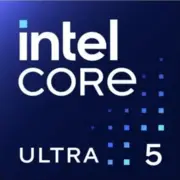Intel Core Ultra 5 134U

Intel Core Ultra 5 134U: A Versatile Processor for Thin Laptops
Overview of Features, Comparison with Competitors, and Device Selection Recommendations
Architecture and Process Technology: The Meteor Lake Revolution
The Intel Core Ultra 5 134U processor is one of the first chips based on the Meteor Lake architecture, marking Intel's transition to the new Intel 4 (equivalent to 7 nm) process technology. This advancement has reduced power consumption and increased transistor density.
- Cores and Threads: 12 cores (2 Performance-cores + 10 Efficient-cores) and 14 threads. P-cores support Hyper-Threading (4 threads), while E-cores operate without it (10 threads).
- Clock Speeds: Base frequency for P-cores is 1.2 GHz, with a maximum turbo frequency of 4.4 GHz. E-cores operate at frequencies up to 3.5 GHz.
- Graphics: Integrated GPU Intel Xe-LPG with 64 EU (Execution Units), supporting DirectX 12 Ultimate and 4K@120 Hz output.
The new hybrid architecture is optimized for multitasking: P-cores handle "heavy" applications, while E-cores manage background processes. A separate NPU (Neural Processing Unit) accelerates AI tasks, such as noise reduction in Zoom or system optimization.
Power Consumption and TDP: Balancing Power and Battery Life
The processor’s TDP ranges from 15 W to 28 W, typical for the U-series. Laptop manufacturers can customize this parameter:
- At 15 W, the focus shifts toward battery life.
- At 28 W, the emphasis is on performance (for example, in compact workstations).
Thanks to the Intel 4 process, energy efficiency has improved by 20% compared to the 13th generation (Raptor Lake). This is especially noticeable in low-load scenarios: web browsing or text editing.
Performance: Real-World Scenario Testing
Geekbench 6 Scores:
- Single-Core: 2041 — comparable to top desktop CPUs from previous years.
- Multi-Core: 8525 — sufficient for 1080p video editing or 3D modeling in Blender.
Office Tasks:
- Running 50 tabs in Chrome + Excel + Zoom — no lag.
- Rendering presentations in PowerPoint with animations — 30% faster than the Core i5-1235U.
Multimedia:
- Converting 4K video in HandBrake: ~12 minutes (compared to ~15 minutes for the Ryzen 5 7640U).
- Photo editing in Lightroom: filters applied almost instantly.
Gaming:
- CS2 (1080p, low settings) — 60-70 FPS.
- The Witcher 3 (720p, medium settings) — 40-45 FPS.
- For AAA games, an external graphics card (such as the RTX 4050) will be needed.
Turbo Mode: With active cooling, the processor maintains a frequency of 4.4 GHz for up to 28 seconds, speeding up application launches. However, in thin laptops (e.g., Dell XPS 13), the frequency may drop due to overheating.
Usage Scenarios: Who is the Ultra 5 134U Suitable For?
1. Students and Office Workers — multitasking, document work, and video conferencing.
2. Amateur Creatives — editing short videos, photo processing, light 3D modeling.
3. Travelers — long battery life and portability.
4. Casual Gamers — indie games and cloud gaming (Xbox Game Pass).
Not suitable for:
- Professional 4K editing.
- Heavy gaming without an eGPU.
- Server tasks (e.g., rendering farms).
Battery Life: Up to 10 Hours of Use and Power-Saving Technologies
In laptops with a 60 Wh battery (such as the HP Spectre x360), the processor provides:
- Up to 10 hours of web surfing.
- Up to 7 hours of video editing in Premiere Pro.
Power-saving Technologies:
- Intel Dynamic Tuning — automatically adjusts TDP based on workload.
- Adaptix Sleep — “deep sleep” mode for background applications.
- AI Optimization — NPU distributes tasks between cores, minimizing energy consumption.
Comparison with Competitors: AMD, Apple, and Previous Generations of Intel
- AMD Ryzen 5 7640U (Zen 4):
- Pros: Higher multi-threaded performance (~9200 in Geekbench 6 Multi-Core).
- Cons: Weaker single-thread performance (1987) and less advanced iGPU (Radeon 760M).
- Apple M3:
- Pros: Battery life up to 18 hours, integration with macOS.
- Cons: Limited compatibility with Windows software.
- Intel Core i5-1335U (13th generation):
- Lags behind the Ultra 5 134U by 15% in multi-threaded tasks and 10% in energy efficiency.
Pros and Cons of the Processor
Strengths:
- High single-threaded performance.
- Support for Thunderbolt 4 and Wi-Fi 6E.
- Improved Xe-LPG graphics for light gaming.
Weaknesses:
- Multi-threaded performance lags behind Ryzen 5 7640U.
- Potential throttling in budget laptops due to weak cooling.
Notebook Selection Recommendations
1. Type of Device:
- Ultrabooks (ASUS ZenBook 14, starting at $999).
- Business Laptops (Lenovo ThinkPad T14s, from $1099).
2. What to Look For:
- Cooling: At least two fans for stable Turbo mode.
- Display: IPS or OLED with a resolution of at least FHD.
- RAM: 16 GB LPDDR5X.
- Storage: 512 GB SSD (PCIe 4.0).
3. Avoid:
- Laptops with TN panels and HDDs.
- Devices without Thunderbolt 4 (important for eGPU connection).
Final Conclusion
The Intel Core Ultra 5 134U is an ideal choice for those seeking a balance between performance and battery life in a thin form factor. It is suitable for:
- Freelancers working in cafes or co-working spaces.
- Students needing a laptop for all occasions.
- Home users for streaming video and light creative work.
Key Benefits:
- Future-proof with NPU and AI optimizations.
- Affordable price range for laptops ($800-$1200) in its class.
- Versatility — from work to entertainment.
If you’re not chasing records in gaming or 8K editing, the Ultra 5 134U will be a reliable companion for the next 3-4 years.
Basic
CPU Specifications
Memory Specifications
GPU Specifications
Benchmarks
Compared to Other CPU
Share in social media
Or Link To Us
<a href="https://cputronic.com/cpu/intel-core-ultra-5-134u" target="_blank">Intel Core Ultra 5 134U</a>